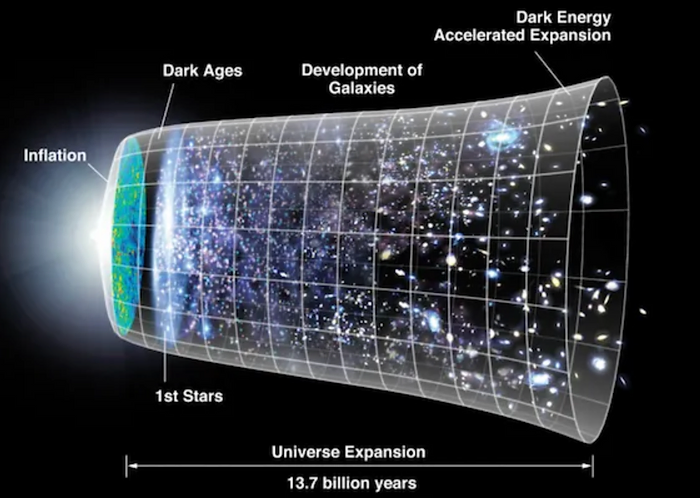More is unknown than is known
The term ‘matter’ is described as a physical substance which occupies space and possess a rest mass. Matter is categorised into various states to ease distinguishability such as, solid, liquid, gas, plasma, and many others. Dark matter makes up roughly 27% of the universe, Dark energy is about 68%, and everything ever observed with instruments from Earth, all normal matter, is classified to be less than 5% of the universe!
Our star, the Sun orbiting the centre of mass of the solar system, has a luminosity of 3.846 x 10²⁶ watts and is the primary source of power for the planets along with various other celestial bodies. A question cleverly raised by various astronomers was, ‘If the Sun is highly luminous, why is space dark?’ Multiple answers as well as paradoxes were published, however two of the most rational explanations to this question was, that space does not have an atmosphere hence there are no particles present to reflect solar rays, which is known as Olbers’ paradox.
Olbers’ paradox is essentially an argument in astrophysics and physical cosmology stating that the darkness of the night sky conflicts with the assumption of an infinite static universe.
Dark matter
Unlike normal matter, dark matter does not interact with the known forces that govern the universe, such as electromagnetic force. Dark matter does not absorb, reflect, or emit light, enabling it from being detected using modern technology. Through modern day research, scientists are more aware of what dark matter is not then what it really is.
Dark matter is not in the form of stars, planets or known astronomical bodies which can be observed. On the other hand, dark matter does not exist in a manner like normal matter, such as in forms of clouds or made of the discovered particles (Baryons). If dark matter were made of baryons, scientists would have been successful in capturing it through the absorption of radiation. At last, dark matter is not antimatter, it does not emit unique gamma rays when antimatter annihilates with matter.
The widely accepted understanding to dark matter is, it consists of particles such as WIMPS (Weakly Interacting Massive Particles) or axions, hypothetical elementary particle having low mass and low energy.
Dark Energy

Evolution of Dark Energy
Dark energy appeared approximately 5 billion years ago and has stayed every since. Its strength, measured by its density, has been constant throughout and is known as the mysterious force behind the accelerating expansion of the universe.
Dark energy can be explained in terms of being a characteristic of space, an intrinsic property of vacuum in space. The first property, Albert Einstein successfully discovered, was that it is possible for more of space to come into existence. This led to the prediction that ‘empty space’ can possess its own energy. With the expanding universe, space is constantly produced resulting with increasing in energy-of-space. However, since energy is a property of space itself, it is not diluted with increasing space. This form of energy thus allows the universe to accelerate its expansion.
What is empty space?
Empty space, or vacuum, is a volume of space which is empty of matter such that its gaseous pressure is lower than the atmospheric pressure. As the name, empty space, suggests that it must be a void region, it consists of the Higgs field and the spacetime curvature. The Higgs field is known as the vacuum energy, lowest energy state possible in quantum mechanics. The spacetime curvature, in the absence of matter, is modelled by the cosmological constant. The cosmological constant is a homogeneous energy density accelerating the expansion of the universe.
Characteristics of Dark matter
Although dark matter has not yet been seen or detected in labs, its presence is observed by gravitational effects. Dark matter accounts for distortions in images of distant galaxies, caused by the light arriving bends around the gravitational fields of other galaxies. Normal matter does not cause the amount of distortion dark matter has been observed to.
Dark matter can alter the way galaxies rotate; it causes the edge of galaxies to rotate faster than expected in the presence of normal matter. It acts as gravitational glue binding clusters of galaxies together which would break apart otherwise.
Astronomers have methods of tracking the total mass in the universe, it has been concluded that the amount of matter in the universe is far greater than seen. Hence, dark matter must have mass even though it has not been observed yet.
Will we ever see dark matter?
Since the 1990s, scientists have been making several attempts in creating large experiments aiming to capture dark matter particles, however, have continued to come up empty-handed.
Since dark matter is challenging to detect, it may be valid to assume the reason can be that dark matter particles react with wavelengths outside the electromagnetic spectrum, that we cannot sense. Possibly such wavelengths which have not yet been discovered in physics, hence we may not have the correct instruments that can detect dark matter.
Since most instruments used in astronomy primarily aim to dive into the universe and extract the unknown, they make use of technology able to detect wavelengths ranging in the electromagnetic spectrum. An assumption, that certain parts of the universe may have different frequencies, which do not occur in the known wavelengths, and can only be distinguished by instruments aligned to sense those, may be logical to why we have not yet successfully detected dark matter.
References
Organisation: (NASA), Title: (Dark energy, Dark matter), URL: ((https://science.nasa.gov/astrophysics/focus-areas/what-is-dark-energy) last accessed: 15/07/2023)
Organisation: (NASA), Title: (How do we see dark matter?), URL: (https://www.jpl.nasa.gov/edu/teach/activity/how-do-we-see-dark-matter/#) last accessed: (22/07/2023)
Author: Paul Sutter, Last updated: (March 04, 2020), Title: (Did dark energy cause the big bang?), URL: (https://www.space.com/did-dark-energy-cause-big-bang.html) last accessed: (22/07/2023)